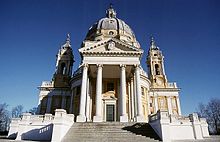This article needs additional citations for verification .(December 2012) |
| |||
|---|---|---|---|
| Buildings and structures +... |
The year 1731 in architecture involved some significant events.
This article needs additional citations for verification .(December 2012) |
| |||
|---|---|---|---|
| Buildings and structures +... |
The year 1731 in architecture involved some significant events.


Baroque architecture is a highly decorative and theatrical style which appeared in Italy in the early 17th century and gradually spread across Europe. It was originally introduced by the Catholic Church, particularly by the Jesuits, as a means to combat the Reformation and the Protestant church with a new architecture that inspired surprise and awe. It reached its peak in the High Baroque (1625–1675), when it was used in churches and palaces in Italy, Spain, Portugal, France, Bavaria and Austria. In the Late Baroque period (1675–1750), it reached as far as Russia, the Ottoman Empire and the Spanish and Portuguese colonies in Latin America. In about 1730, an even more elaborately decorative variant called Rococo appeared and flourished in Central Europe.
This is a timeline of architecture, indexing the individual year in architecture pages. Notable events in architecture and related disciplines including structural engineering, landscape architecture, and city planning. One significant architectural achievement is listed for each year.
The year 1814 in architecture involved some significant events.
The year 1782 in architecture involved some significant events.
The year 1857 in architecture involved some significant events.

Neoclassical architecture, sometimes referred to as Classical Revival architecture, is an architectural style produced by the Neoclassical movement that began in the mid-18th century in Italy, France and Germany. It became one of the most prominent architectural styles in the Western world. The prevailing styles of architecture in most of Europe for the previous two centuries, Renaissance architecture and Baroque architecture, already represented partial revivals of the Classical architecture of ancient Rome and ancient Greek architecture, but the Neoclassical movement aimed to strip away the excesses of Late Baroque and return to a purer, more complete, and more authentic classical style, adapted to modern purposes.
The year 1807 in architecture involved some significant events.
The year 1751 in architecture involved some significant events.
The year 1805 in architecture involved some significant events.
The year 1882 in architecture involved some significant architectural events and new buildings.
The year 1727 in architecture involved some significant events.
The year 1829 in architecture involved some significant events.
The year 1916 in architecture involved some significant events.

French Baroque architecture, usually called French classicism, was a style of architecture during the reigns of Louis XIII (1610–1643), Louis XIV (1643–1715) and Louis XV (1715–1774). It was preceded by French Renaissance architecture and Mannerism and was followed in the second half of the 18th century by French Neoclassical architecture. The style was originally inspired by the Italian Baroque architecture style, but, particularly under Louis XIV, it gave greater emphasis to regularity, the colossal order of façades, and the use of colonnades and cupolas, to symbolize the power and grandeur of the King. Notable examples of the style include the Grand Trianon of the Palace of Versailles, and the dome of Les Invalides in Paris. In the final years of Louis XIV and the reign of Louis XV, the colossal orders gradually disappeared, the style became lighter and saw the introduction of wrought iron decoration in rocaille designs. The period also saw the introduction of monumental urban squares in Paris and other cities, notably Place Vendôme and the Place de la Concorde. The style profoundly influenced 18th-century secular architecture throughout Europe; the Palace of Versailles and the French formal garden were copied by other courts all over Europe.
The year 1776 in architecture involved some significant events.
The year 1815 in architecture involved some significant events.
The year 1756 in architecture involved some significant events.
The year 2017 in architecture included the demolishment of a major brutalist building, several dedications and openings of new buildings, and two major disasters.
The year 2016 in architecture involved some significant architectural events and new buildings.